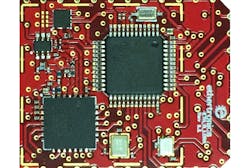LoRa technology is regarded as a key player for Internet of Things/machine-to-machine (IoT/M2M) applications. Based on spread spectrum technology, LoRa allows for long-range, low-date-rate communications. In North America, LoRaWAN networks operate in the 902-to-928 MHz frequency band, while Europe uses 867 to 869 MHz. Some of the various applications that can be enabled by LoRa technology are intelligent buildings, agriculture, and logistics.
One company, Ethertronics, recognized the need for antennas for LoRa-based products. Hence, Ethertronics—which is a member of the LoRa Alliance—essentially decided to create its own solution. Those efforts have resulted in the new ETH-LORA-M-AX-0110 LoRa module (Fig. 1).
1. This LoRa module operates in the 868- and 915-MHz bands.
The ETH-LORA-M-AX-0110 is a plug-and-play LoRa module that enables low-power-wide-area-network (LPWAN) connectivity. It operates in the unlicensed 868- and 915-MHz frequency bands. The module combines Semtech’s SX1272 LoRa transceiver with Ethertronics’ Active Steering and impedance matching solutions. Ethertronics’ EC686 chipset, which is a single-pole, four-throw (SP4T) for antenna tuning applications, is utilized in the module’s architecture (Fig. 2).
2. Shown is the LoRa module’s hardware architecture.
Ethertronics’ motivation, essentially, is to deliver a complete LoRa device solution. This solution includes a LoRa module, antennas, testing, software integration support, and pre-certification. “We want to be a one-stop shop to allow customers to bring a LoRa application to market,” explained Jeff Shamblin, the company’s chief scientist.
Module Features
One key feature of the ETH-LORA-M-AX-0110 module is its impedance matching capability. This capability allows power transfer between the radio and antenna to be maximized. The company maintains that this impedance-matching capability helps to overcome potential antenna detuning caused by the surrounding environment.
In addition, Active Steering technology offers the capability of generating three radiation patterns. This technology essentially enables a communication link to be optimized dynamically. IoT/M2M applications can benefit from real-time adjustments, which are made possible by Active Steering technology. Thus, customers can place their IoT/M2M device in virtually any location, according to Ethertronics.
In terms of performance, the ETH-LORA-M-AX-0110 module has a performance range in excess of nine miles. It also has an expected battery lifetime of 2 to 10 years—depending on the application. The module takes advantage of a real-time, multi-task operating system (RTX OS). Its command interface is intended to increase flexibility and speed integration. The module measures 20 × 25 mm. Samples are available now.
Ethertronics Inc., 5501 Oberlin Dr. Ste. 100, San Diego, CA 92121; (858) 550-3820



